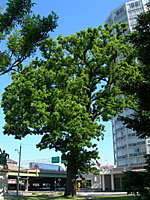Terry L. Ettinger Horticulture Consulting Services
Meeting The Needs Of Today With A Vision For The Future
Special Topics
Your Tree May Be in Trouble If . . .
Introduction
 Itís often assumed that trees live
"forever."
Itís often assumed that trees live
"forever."
In fact, however, the oldest living tree on earth is thought to be a quaking aspen clone in south-central Utah thatís "only" 10,000 years old. Closer to home, itís possible to find trees in isolated forests, swamps and woodlots throughout the northeastern U.S. that may be in the vicinity of 500 years old.
Unfortunately, the life expectancy of trees drops quickly as they come into more frequent contact with people; from approximately 150 years on large suburban properties, down to only 32 years on a typical city lot, and a mere seven years along downtown streets. As a testament to their durability, however, the bur oak (Quercus macrocarpa) in the picture at the top of this page is estimated to be in the vicinity of 150 years old, and is doing quite well in a small park near the very heart of downtown Syracuse!
Clicking on the links at right will provide you with brief descriptions and photographs of common conditions that threaten the health of trees in landscape settings. If you pause for just a moment, however, you may note that none of these links refer directly to insect infestations or diseases.
That's because, at least in upstate New York, there are very, few insects or diseases that can cause the death of healthy trees. Rather, they almost always attack trees that have been compromised by one or more of the conditions you'll read about by clicking on the links at right.
Depending upon the severity of the condition(s) affecting your tree(s), their chances for survival without significant, ongoing maintenance over many years may be questionable. What's beyond question, however, is the very real danger they may pose to nearby structures, utilities, and vehicles if they fail!
Therefore, if a tree or trees in your landscape present any of the conditions described on the pages the links at right lead to, I strongly recommend that you consult with an International Society of Arboriculture-certified Arborist or New York State Certified Nursery & Landscape Professional as soon as possible.
For a closer look at a variety of symptoms that may indicate that your trees may be in trouble, watch episodes of my Time Warner Cable Television program, "Garden Journeys," by clicking here.